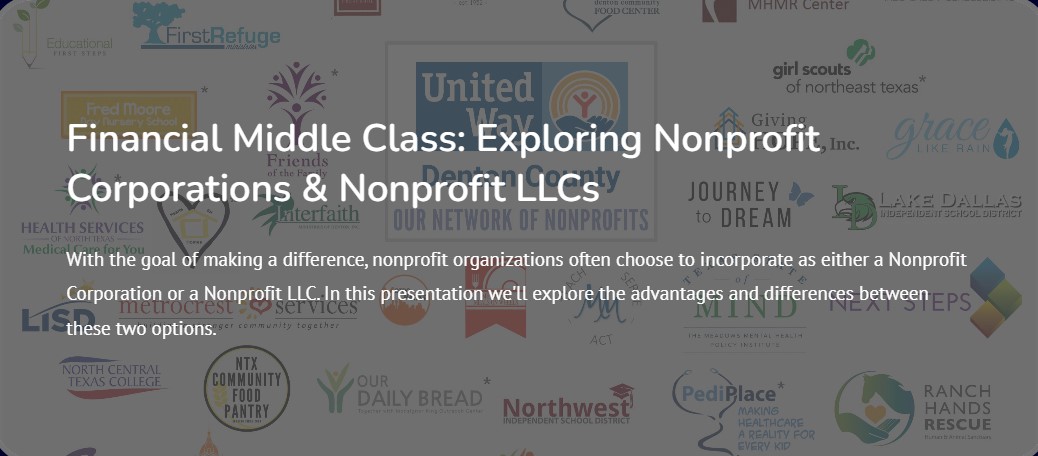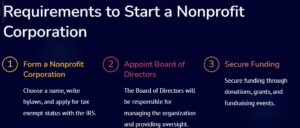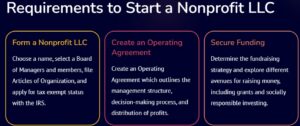
Nonprofit Corporations vs. Nonprofit LLCs
By MacKenzy Pierre
The estimated reading time for this post is 251 seconds
Nonprofit Corporation vs. Nonprofit LLC: Understanding the Advantages and Differences
United Way Worldwide, Feeding America, and the American Red Cross are among the largest nonprofit organizations in the United States. They are crucial in addressing social issues, championing charitable causes, and positively impacting communities worldwide.
Although their governance is to impact communities rather than enhance shareholders’ wealth, nonprofit organizations still have to be established and structured legally. Nonprofit Corporations and LLCs have legal recognition and protection to fulfill their philanthropic missions.
This article explores the advantages and differences between incorporating as a nonprofit corporation and a nonprofit Limited Liability Company (LLC).
Understanding these options is crucial for nonprofit leaders, as their decisions will profoundly impact the organization’s ability to pursue its goals effectively and ethically.
Nonprofit Corporation: Empowering Vision through Formality

Nonprofit Corporation
Nonprofit corporations stand as time-tested social impact pillars, their purpose-driven ethos resonating deeply with countless missions worldwide. Their legal structure, governed by state laws, grants them several distinct advantages contributing to their popularity among nonprofit organizations.
Limited Liability: A nonprofit corporation’s most significant advantage is its limited liability to its directors, officers, and members.
This legal protection ensures that personal assets remain shielded from the financial and legal obligations incurred by the organization. As a result, individuals can fearlessly pursue their social goals, secure in the knowledge that their personal finances are not at stake.
Tax-Exempt Status: The allure of federal tax-exempt status, as granted under section 501(c)(3) of the Internal Revenue Code, beckons nonprofit corporations.
This designation bestows tax deductibility upon donations, motivating individuals and corporations to contribute to the cause. As fundraising success amplifies, nonprofits can further propel their mission and impact.
Permanence and Stability: Nonprofit corporations typically possess perpetual existence, transcending the involvement of founding members or key personnel. The permanence grants a sense of stability, ensuring the organization’s commitment to its goals endures across generations.
Governance Structure: A hallmark of nonprofit corporations is their formalized governance structure. Governed by a board of directors, these organizations uphold transparency, accountability, and compliance with the mission, enhancing public trust and credibility.
Forming a Nonprofit Organization
Forming a nonprofit organization requires the same steps as starting other corporations:
- Select a name for the corporation
- Submit Articles of Incorporation to the Secretary of State (or other agency)
- Make corporate bylaws
- Apply for tax-exempt status
Nonprofit LLC: Pioneering New Avenues of Social Good

Nonprofit LLC
The emergence of nonprofit LLCs recently brought forth a fresh perspective on blending mission-driven objectives with a flexible operational approach. Although unavailable in all states, nonprofit LLCs offer unique attributes that appeal to specific nonprofit organizations.
Limited Liability: Similar to their nonprofit corporation counterparts, nonprofit LLCs prioritize limited liability protection for their members. This safeguard ensures that personal assets remain inviolable, empowering members to pursue innovative strategies without excessive fear of financial repercussions.
Operational Flexibility: The allure of a nonprofit LLC lies in its operational agility and adaptability. These entities can engage in more diverse activities, spanning charitable and business-oriented endeavors. Such flexibility benefits organizations seeking diverse revenue streams or venturing into social enterprises.
No Federal Tax-Exempt Status: Unlike nonprofit corporations, nonprofit LLCs do not automatically qualify for federal tax-exempt status under section 501(c)(3). Nonetheless, depending on the jurisdiction, they may still be eligible for certain state tax exemptions.
Member-Managed Structure: The informal and member-managed structure of nonprofit LLCs empowers individuals with a heightened sense of control and autonomy. This participatory approach fosters a dynamic environment, stimulating creativity and collaboration.
Differences Between Nonprofit Corporations and Nonprofit LLCs: Paving the Path to Purpose
To discern the most suitable path, nonprofit leaders must weigh the disparities between nonprofit corporations and nonprofit LLCs.
Tax Implications: The allure of federal tax-exempt status remains a hallmark of nonprofit corporations, enabling them to offer tax deductions to generous donors. Nonprofit LLCs, however, must rely on state-level tax exemptions, which may vary significantly in scope and magnitude.
Governance Structure: Nonprofit corporations embrace formalized governance, with a board of directors assuming the mantle of responsibility. Nonprofit LLCs, in contrast, offer a more flexible management approach driven by member involvement and input.
Permissible Activities: Nonprofit corporations must maintain their tax-exempt status by limiting their activities to charitable and nonprofit endeavors. Nonprofit LLCs, while adhering to social impact, can explore revenue-generating initiatives that align with their mission.
Conclusion
The choice between incorporating as a nonprofit corporation or a nonprofit LLC is pivotal for organizations dedicated to purposeful impact.
Nonprofit corporations, nestled in their formal structures, offer the allure of federal tax-exempt status and enduring stability. Conversely, nonprofit LLCs have new horizons with operational flexibility and member-driven engagement.
As nonprofit leaders embark on this momentous decision, it is essential to discern the alignment between the chosen legal structure and the organization’s unique mission.
By thoughtfully considering the advantages and differences presented, nonprofit organizations can blaze their path to purposeful impact, transforming lives and empowering communities on their journey to a brighter, more compassionate future.
Senior Accounting & Finance Professional|Lifehacker|Amateur Oenophile
RELATED ARTICLES
In Search of the Next Asset Bubble
The estimated reading time for this post is 308 seconds From Dot-com to U.S. Housing to Chinese Real Estate, there have been about nine notable global asset bubbles since the Great Depression. The most recent was the Special Purpose Acquisition...
Yes,Bitcoin Is a Financial Asset
The estimated reading time for this post is 239 seconds Yes, Bitcoin is a financial asset, but it’s not ready yet to be inside your 401(k), 403(b), and Traditional IRAs. If you know me, then you know that’s breaking news. ...
Leave Comment
Cancel reply

In Search of the Next Asset Bubble

Biggest Financial Crimes: Washington Mutual Financial Scandal

How Much is a Mortgage on a $700,000 House
Gig Economy
American Middle Class / Jul 20, 2024
In Search of the Next Asset Bubble
The estimated reading time for this post is 308 seconds From Dot-com to U.S. Housing to Chinese Real Estate, there have been about nine notable global...
By MacKenzy Pierre
Fraud & Financial Crimes / Jul 16, 2024
Biggest Financial Crimes: Washington Mutual Financial Scandal
The estimated reading time for this post is 249 seconds Biggest Financial Crimes: Washington Mutual Financial Scandal Washington Mutual, once the largest savings and loan association...
By Article Posted by Staff Contributor
American Middle Class / Jul 16, 2024
How Much is a Mortgage on a $700,000 House
The estimated reading time for this post is 193 seconds As of mid-2024, the housing market continues to navigate a complex landscape shaped by fluctuating interest...
By MacKenzy Pierre
American Middle Class / Jul 14, 2024
Financial Literacy: Building a Foundation for Financial Well-being
The estimated reading time for this post is 206 seconds Financial literacy is a critical skill that empowers individuals to make informed decisions about their financial...
By Article Posted by Staff Contributor
Stock News / Jan 02, 2024
Re-Drafting the 2023 IPO Class
The estimated reading time for this post is 147 seconds The Initial Public Offering (IPO) market is a significant barometer for economic health and investor sentiment. ...
By MacKenzy Pierre
Stock News / Dec 29, 2023
2024 IPO Draft Class
The estimated reading time for this post is 151 seconds 2024 IPO Draft Class: Ranking the Top Prospects Following the pattern of last year’s tumultuous market...
By MacKenzy Pierre
Stock News / Dec 22, 2023
Build Wealth with Boring Investments
The estimated reading time for this post is 314 seconds Due to their boredom, long-term, low-cost, and passive investing strategies have lost ground to more speculative...
By MacKenzy Pierre
Finance / Dec 10, 2023
Yes,Bitcoin Is a Financial Asset
The estimated reading time for this post is 239 seconds Yes, Bitcoin is a financial asset, but it’s not ready yet to be inside your 401(k),...
By MacKenzy Pierre
Business / Nov 24, 2023
Cash Management for Growing Businesses
The estimated reading time for this post is 147 seconds Cash Management for Growing Businesses: Navigating the Waters of Growth and Liquidity In the early stages,...
By MacKenzy Pierre
Fraud & Financial Crimes / Nov 21, 2023
Biggest Financial Crimes: Adelphia
The estimated reading time for this post is 255 seconds Biggest Financial Crimes: Adelphia Adelphia Communications Corporation, once a titan in the cable industry, became synonymous...
By Article Posted by Staff Contributor
Latest Reviews
American Middle Class / Jul 20, 2024
In Search of the Next Asset Bubble
The estimated reading time for this post is 308 seconds From Dot-com to U.S. Housing...
Fraud & Financial Crimes / Jul 16, 2024
Biggest Financial Crimes: Washington Mutual Financial Scandal
The estimated reading time for this post is 249 seconds Biggest Financial Crimes: Washington Mutual...
American Middle Class / Jul 16, 2024
How Much is a Mortgage on a $700,000 House
The estimated reading time for this post is 193 seconds As of mid-2024, the housing...



